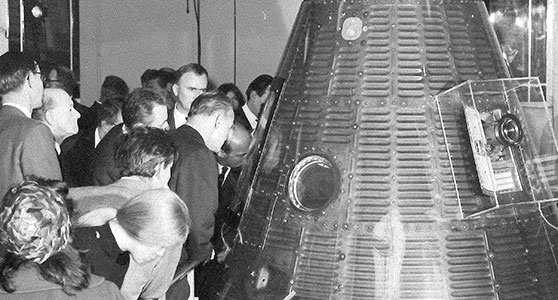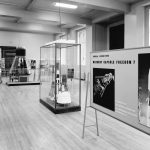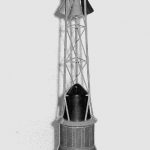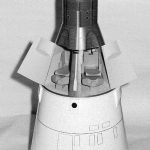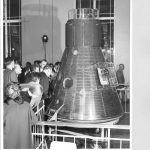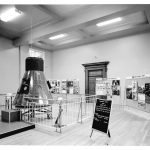‘Something simple and striking, if not amusing’ – the Freedom 7 special exhibition at the Science Museum, 1965
Article DOI: https://dx.doi.org/10.15180/140105
Abstract
From October 1965 to May 1966, the Science Museum in London displayed the American spacecraft Freedom 7, the first capsule in NASA’s Mercury programme to take a human on a suborbital flight. Archival records concerning this temporary display are extensive and contain photographic sources as well as written ones. This case therefore lends itself to a study aimed at evaluating the comparative merits of these two types of records, for understanding the logic at play in the display, and for retrieving at least part of the visitors’ experience. Visual sources emerge from this comparison as invaluable records for accessing the materiality of this temporary exhibition. They demonstrate that the Freedom 7 special exhibition was a key moment in the establishment of a space science and technology section at the Science Museum, as it enabled the Museum to begin historicising what was then a new field of scientific and technological enquiry. The exhibition follows a logic of display theorised in 1950 by Henry Calvert, a senior curator, in a note recently discovered in the Science Museum’s archives. It is based on the display of a star object that draws visitors’ attention towards less charismatic exhibits.
Keywords
Freedom 7, Henry Calvert, history of museum practices, Science Museum, Space exploration, visual sources
Introduction
https://dx.doi.org/10.15180/140105/007This paper presents a case study of the display of the Mercury space capsule Freedom 7 at the Science Museum, in London, in 1965–66. The paper has two overarching objectives: firstly, it will reflect on the way displays of science and technology were delivered in the Science Museum in the 1960s. Based on the example of this temporary exhibition, the paper will suggest that display strategies commonly thought of as having originated in the 1980s can in fact be traced back some decades earlier. Indeed, analysis of documents suggests that some of these ideas were around in the 1950s: for example the use of a few and ‘ruthlessly selected’ (Nahum, 2010, p 189) exhibits instead of whole collections, or the idea that scientific and technical artefacts have an aesthetic value meriting forms of displays similar to those found in sculpture galleries and art museums.
The paper will suggest that temporary exhibitions prove particularly helpful for questioning received assumptions about the development of museum display techniques and policies. Permanent galleries, which often remain unchanged for at least two or three decades, are not flexible enough to serve as indexes of changes in museum practices in relation to changes in the wider cultural context (MacDonald, 1996). By contrast, temporary exhibitions enable us to acquire a detailed historical understanding of the development of museum practices on an almost yearly basis (Morris, 2010b).
As a second objective, this paper is intended as a modest contribution to the literature arguing for the significance of visual artefacts (such as photographs) as sources for historiography (Jordanova, 2012). The departure point for this article is itself a photograph depicting the Freedom 7 special exhibition, which was taken for the explicit purpose of documenting the physical form of the exhibition (Figure 1).
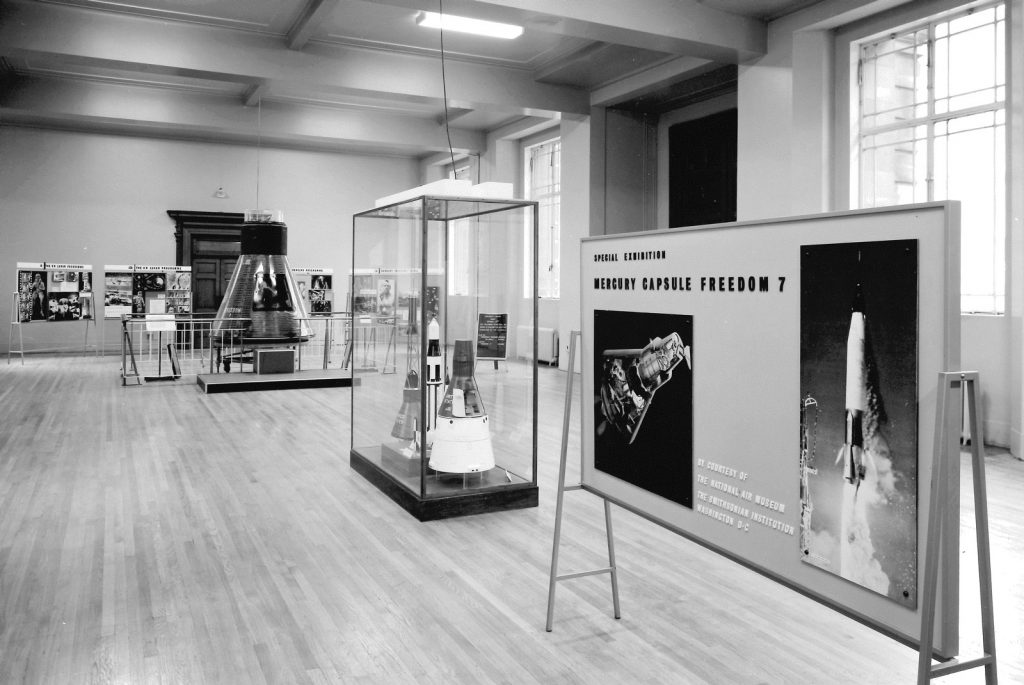
This paper shows that a close reading of such visual records, regarding the choice of exhibits and the architecture of the display, leads to new conclusions about the historical significance of the display, and adds to any understanding of museum practices gained from textual sources alone. Photographs allow us, as distant observers, to engage with material aspects of a display that often embody unarticulated museological skills and understandings. These skills and understandings are often tacit and remain unacknowledged by museum professionals. They are thus invisible in the written records produced by the historical actors who set up exhibitions.
Visual records analysed in conjunction with written ones also enable us to get a more detailed understanding of the conceptions museum curators held of visitors, what they thought visitors’ expectations were, and how they thought these expectations should be taken into account when constructing the display (Schmid, 2006). The present paper will suggest that such conception, in the case of the Science Museum in the mid-1960s, revolved around notions of entertainment and self-improvement.
This paper is intended to engage with the display as a material artefact, as a constructed thing, in a way that allows us to retrieve as much as possible of the agency of those who produced but also consumed it (Alder, 2007). It therefore contributes to the literature reflecting on the history of the material construction of displays, which has already covered a lot of ground[1].
In particular, Ghislaine Lawrence (1996) has usefully drawn attention to ‘the spectacular’ as a meaningful category for understanding the history of those aspects of exhibition, mostly visual, whose ‘handling … is rooted in practices which have become conventionalized, largely unacknowledged and often self-imposed by curators and designers’ (p 69). The specific contribution of the present paper is to offer, through the close study of an individual case, a more detailed understanding of the history of display practices at the Science Museum during the mid-1960s.
The period can be thought of as significant for the Science Museum, for it follows the start in May 1964 of the television series Horizon. We may thus expect that this development in the British mediascape led to some evolution in the Museum’s visual language. Indeed, as I discuss elsewhere (Gouyon, 2014), historical evidence shows that staff at the Science Museum perceived the development of BBC2, and of Horizon in particular, as elements they should take into account when thinking of what the Museum could offer. For instance, the annual report of the Science Museum for 1964 contains the following remark:
‘out-of-school background science programmes are increasing in number and quality especially with the introduction of B.B.C.2 and to an ever-increasing extent are sating the public appetite for science lectures. Why should a family party spend a considerable amount of time and money to travel to the Science Museum for a lecture when they have a weekly choice of several first class science programmes on their own hearth?’[2]
As the present paper suggests, such awareness of the concurrence represented by science television programmes will translate, on the one hand, into a foregrounding of the Museum’s capacity to offer visitors the possibility of experiencing the presence of historical artefacts, and on the other into some form of reassertion of the Museum’s expertise in producing historical knowledge of science and technology. This latter idea was not alien to Science Museum staff in the 1960s (Anthony, 2010). In 1955 already, Frank Sherwood Taylor (then Director of the Museum) forcefully asserted that ‘the object of the Museum may on this view be stated briefly as to exhibit the achievements, wonder, importance and history of science’[3].
In what follows, I will firstly give an account of the exhibition, based on textual records: the Science Museum’s archives contain detailed papers related to the display. Secondly, I will discuss photographic records of the exhibition and show that analysing them enables a more textured description of the display, which in turn brings a deeper understanding than could have been obtained from texts alone. Lastly, I will suggest an intellectual genealogy for the display strategy exemplified in the Freedom 7 special exhibition. It appears indeed that the layout of the 1965 exhibition can be related to some of the reflection conducted in the preceding decade on how scientific and technological knowledge should be put on display. This is evidenced by a note on the topic authored by Keeper of Astronomy Henry Calvert in 1950, and recently discovered in the Science Museum’s archives (Calvert, 1950). Overall, the present article will propose that there is a relationship between this temporary exhibition and the development of the Science Museum in the 1960s, especially with regard to its appropriation of space science, as manifested by a nascent collection of artefacts related to the topic.
The exhibition as it emerges from written records
https://dx.doi.org/10.15180/140105/008The textual records held in the Science Museum’s archives that describe the Freedom 7 exhibition are extensive, and include some evocative detail. On 6 October 1965 the exhibition was opened to the public and one letter describes how initial plans for the opening ceremony included astronaut John Glenn, but fog eventually prevented Glenn’s flight from landing at Heathrow. The United States ambassador ‘very kindly performed the opening ceremony in his stead’ (Follett, 1965).
The capsule was the first in the Mercury programme to have carried a human passenger, Alan Shepard[4]. It was on loan for six months from the National Air Museum at the Smithsonian Institution and had been obtained following protracted negotiations, conducted in the hope that the Science Museum would receive the capsule for permanent exhibition.
Placed in the ‘Special Exhibition Gallery’ on the ground floor of the Museum, the spacecraft was accompanied by ‘exhibition material … provided from the museum’s own Space Science and Technology section together with photographs specially provided by the American Embassy, … which were mounted on four panels’[5]. This additional material was meant ‘to provide background information on the sub-orbital flight of Freedom 7’[6]. In addition a tape recording providing details of the significant features of the artefact was run ‘in the immediate neighbourhood of the Capsule’. The recording included an extract of the communication between the capsule and ground control, featuring Alan Shepard’s voice (Follett, 1965).
The exhibition was considered ‘highly successful’ (Follett, 1966). In total 347,643 visitors came to see the spacecraft, and it was necessary to make special arrangements so that people could see the capsule during the weekends, to satisfy an enthusiastic demand. But what did this eager audience actually experience?
Thanks to a report from an individual visitor we can get an idea of the exhibition space. This visitor was Robert Plenderleith, a curator at the Royal Scottish Museum in Edinburgh, who was there to get a sense of the physicality of the display, since after the London show the spacecraft would be exhibited in Scotland for a further six months[7]. Plenderleith’s report is of particular interest as a historical source as we can assume that its author had an educated eye when it came to looking at museum displays. But because of the informed perspective of its author, this document cannot be mistaken as a means of accessing actual visitors’ experience. For that matter, as will appear, Plenderleith explicitly distances his perception of the display from that of ‘the visitor’. He writes:
‘To back up the central exhibit, the Science Museum prepared and added four wall panels of labelled photographs and posters by way of descriptive material and also a case showing models from their own collection of several types of American rockets.
‘In the display, the Capsule is surrounded by a railing and can only be closely approached from one side. Here a platform has been laid to raise the visitor to a position from which he can conveniently look down through a window and examine the illuminated interior. Immediately in front of the window a wooden step on the platform allows younger visitors to stand high enough to see within where an effigy of Commander Shepard, in full kit, is seen surrounded by a mass of instruments, controls and indicators.’ (Plenderleith, 1965)
This description adds a few elements to what had already been retrieved from the Science Museum’s summary of events, or the letters from the Museum’s Director, David Follett, to his opposite number in Washington, DC, Paul Johnston. For instance, we now know that the spacecraft was surrounded by a railing and could only be approached from one side, thus suggesting an effort on the Museum’s part to control the way visitors interacted with the capsule.
We also learn that this display repeated the key attraction of the earlier display of another Mercury capsule, Friendship 7, in 1962 at the Science Museum: the possibility of looking inside the capsule through its window (Gouyon, 2014). The citation of the Friendship 7 exhibition is not fortuitous. The wooden step installed on the platform in front of Freedom 7 to allow ‘younger visitors to stand high enough to see within’ was in fact added to the display after a mother complained that her son could not look inside the capsule, as he had been able to do on the occasion of the display of Friendship 7, three years earlier. This indicates, in turn, that audiences learn ways of interacting with artefacts through encountering them in museum displays. These interactions create expectations about how subsequent displays of similar artefacts should be designed. Museum displays can thus be said to create a familiarity with unfamiliar objects through the possibility they offer of repeated encounters.
Finally, Plenderleith’s report mentions ‘a case showing models from their own collection of several types of American rockets’ thus shedding some light on what is described only as ‘exhibition material … provided from the museum’s own Space Science and Technology section’, in the summary of events. Later in his report, when discussing the possibility that these models could travel to Edinburgh with the capsule, Plenderleith notes that the suggestion ‘raised difficulties as the permanent collection had been temporarily weakened and models of rockets, etc., would require to be returned to the permanent display’ (Plenderleith, 1965). This last comment suggests that the Museum had a very embryonic collection, which would be consistent with the fact that the decision to form a ‘Space Science and Technology Section’ was taken in January of 1962 (Millard, 2010). The Freedom 7 exhibition was thus a means for the Museum to showcase its own collection.
Plenderleith’s report works backwards compared with what an incoming visitor’s itinerary in the exhibition space might have been. It begins with the panels installed at the back of the room and then makes its way towards the entrance of the exhibition space. This characterises the document as a display analysis rather than a report by a visitor. It also provides us with precious information as to what matters to the author, as a museum professional. The first things Plenderleith looks at are what ‘back[s] up the central exhibit’. The panels ‘of labelled photographs and posters’ and the ‘case showing models from their own [the Science Museum’s] collection of several types of American rockets’.
The emphasis placed in this report on the support material is confirmed in further correspondence between Plenderleith and the Science Museum. It can be interpreted as evidence that when a museum curator in the 1960s contemplated the notion of displaying such a major artefact as the Mercury capsule, the object was conceived of in terms of its power of attraction towards some back-up material. An important question to ponder for a curator was: how best could this power of attraction be exploited in order to present scientific and technical information?
Plenderleith’s report provides some notion of the display, the kind of sensory experience visitors were offered, and also of the kind of knowledge the exhibition was intended to impart. It also suggests that the support material was a key part of the display. But this written description remains somehow superficial. It does not allow, for instance, for a full understanding of the logic at play in the exhibition, and several questions are still unanswered. For instance, what was the architecture of the display? What was its scale? How were the different elements – capsule, showcase, panels – positioned in relation to one another? What kind of itinerary were visitors encouraged to follow? What claims to knowledge emerge from the display and are supported by it?
Museum workers, the constructors of displays, often think visually, as well as in three dimensions. It is no surprise that Plenderleith, the emissary of the Royal Scottish Museum, perhaps aware that his report could not allow the reader to form an adequate mental representation of the display or answer some of the questions above, also took a film of the exhibition. Back in Edinburgh, he sent a print of it to Walter Tuck, at the Science Museum, for not only was the film ‘a good record of the operation’, it was also ‘a good record of members of staff’ (Plenderleith, 1966)[8]. Similar expressions of trust in visual documentation, as a means of transmitting information about the physicality of the display, surface in the correspondence between the Science Museum and the National Air Museum, as photographs ‘specially taken to show how we have presented the Capsule and its illustrated material’ (Follett, 1965) were sent across the Atlantic to Washington, DC.
Learning from a photograph
https://dx.doi.org/10.15180/140105/009The photograph to which we turn now was part of this series sent to Paul Johnston in November 1965 which was intended to show what the display looked like. This particular photograph (See Figure 1) is a general view of the Freedom 7 special exhibition as seen from the entrance.
It shows a highly structured display, with clearly defined lines of sight, and an implied route through the exhibits. On entering the exhibition space, visitors first encounter the panel announcing the title of the exhibition and crediting the National Air Museum. Instead of commanding a halt on the threshold of the display, this panel acts as a pointer towards the centrepiece at the end of the room, suggesting an itinerary that passes beside the showcase presenting the models from the Museum’s own Space Science collection.
The case contains five models, each representing a stage in the progression of US space science and technology. Two are of space capsules: a Mercury spacecraft and a Gemini one (Figures 2 and 3)[9].
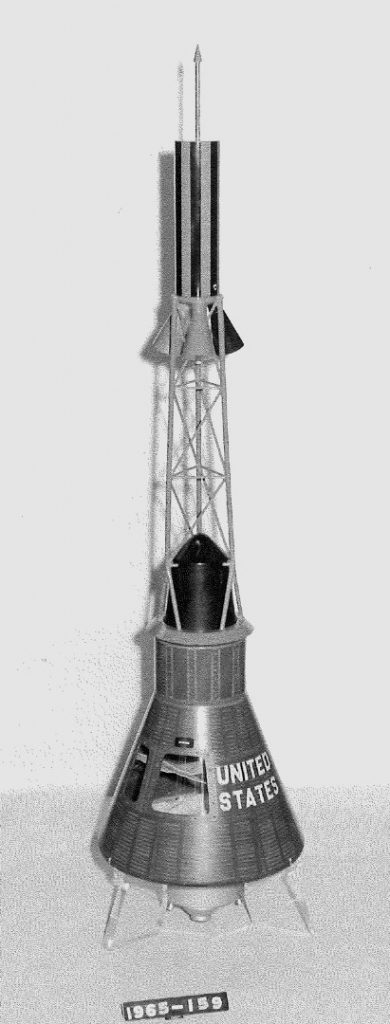
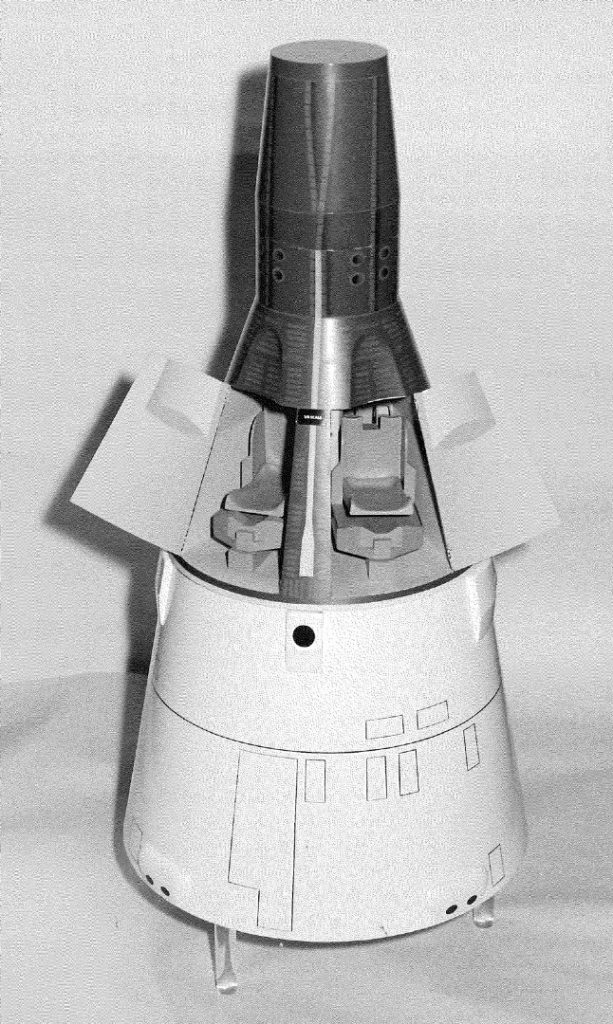
Three are of rockets: a V-2, a Mercury Atlas and a Saturn C-1[10]. Together, these five models tell a story of the US space programme from the immediate post-war period (with the appropriation of the German V-2 technology) to 1965 when the Gemini project was in full swing, and launch vehicles capable of propelling spacecraft such as the Mercury and the Gemini capsules had been developed. As the object numbers indicate, these five models were quite recent additions to the Museum collection. The rocket models were part of the first series of eight models of rocket boosters commissioned from the model-maker Shawcraft, in Uxbridge, and received at the Museum in March and December 1964[11]. The capsule models, which were gifts from the MacDonnell Corporation to the Museum, had reached the Museum only a few months before the opening of the exhibition[12]
This showcase display, considered in relation to the entire exhibition, can be seen as an early attempt by the Science Museum to position itself as able to historicise space science and technology. The Gemini model was labelled thus:
‘Here is presented the two-man capsule used by the U.S.A. as an interim vehicle designed to evaluate more complex manoeuvres in space following from the Mercury flights and leading on to the Apollo programme.’[13][12]
In 1965, NASA’s Mercury programme had already been replaced by the Gemini project. And this label tells a narrative of progress from Mercury through Gemini to Apollo, from Earth up to the Moon, in an ideal and smoothed-out trajectory with increased levels of complexity, and from which asperities and accidents are erased. Freedom 7 stands as the departure point of this trajectory, the first capsule in the Mercury programme to have lifted a human into space. The label for the model of the Gemini vehicle prepared the visitor to encounter Freedom 7 as a historical artefact. So even more than a topical one, this special exhibition was a historical display, presenting a ‘first’. Indeed, David Follett, in his letter thanking the Director of the National Air Museum, defined the capsule as ‘a unique object and one of great historical interest’ (Follett, 1966).
Displayed alongside the Freedom 7 capsule, the showcase exhibit supports the claim that the Science Museum is to be trusted to impart reliable historical knowledge of space science and technology. Having passed it, visitors would eventually reach the spacecraft itself, which could act like a magnet, drawing visitors forward. There, they would hear the tape recording, played in a loop, detailing the main features of the capsule and coming out of the loudspeaker pair standing on the floor, visually unobtrusive, on each side of the capsule. They would perhaps look at its illuminated interior, and marvel at the intricacy of instruments, controls and indicators. In any case, they would be physically dominated by the artefact, Freedom 7 standing erect on top of a trolley like a pedestal – modern technosculpture for the age of space exploration (Figure 4).
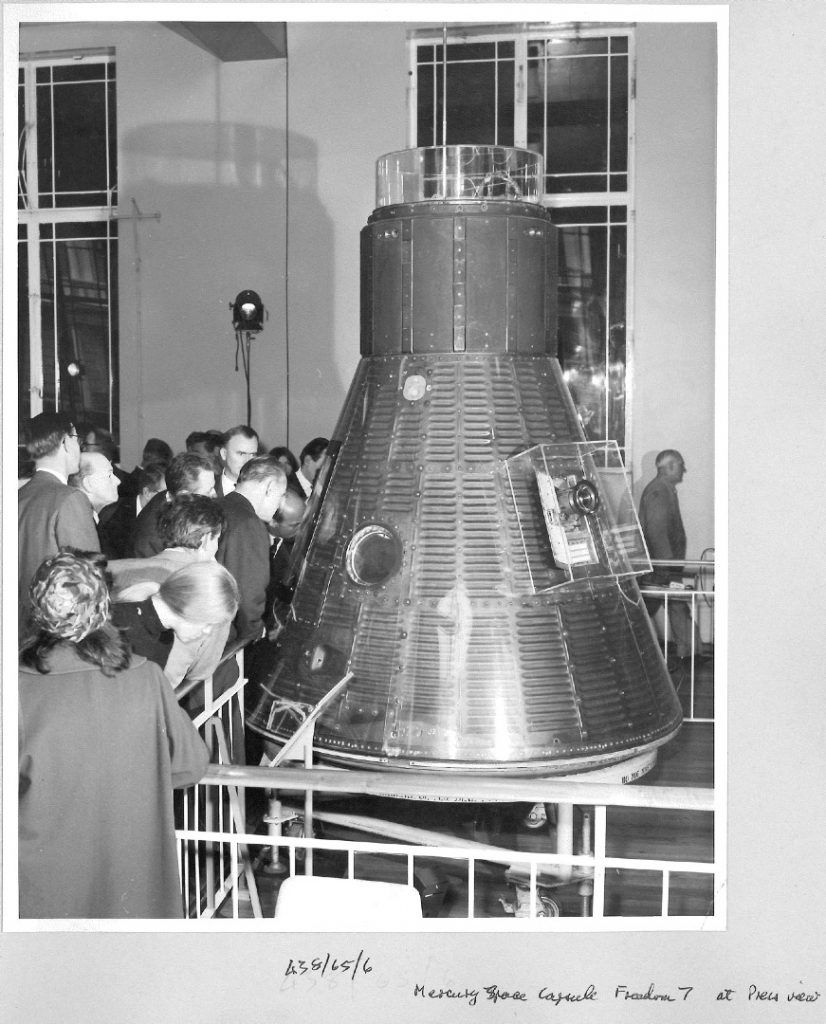
Having reached the focal point in the display, some visitors may then have walked beyond the capsule, and read the four magazine-style panels of labelled photographs and sketches backing the ‘“star” object’ (Tuck, 1965). Here they could obtain additional information on the US lunar programme, the Mercury project and the Freedom 7 flight, the whole enterprise being presented as ‘the continuing programme to further man’s search for useful information about outer space’[14]. This final part of the exhibition adopted an anthropocentric perspective, rather than a technocentric one. Labels provided visitors with information on astronauts’ training, and equipment. The top-left quarter of the third panel showed the photographic portrait of the six astronauts involved in the Mercury programme. The last panel was devoted to Alan Shepard’s experience during his flight. To place the emphasis on human agency made it easier for visitors to relate to this new field of knowledge.
Finally, as the easel standing on the right-hand side of the capsule reveals (Figure 5), for those visitors still willing to get more information, two film shows a day were arranged in the Children’s Gallery cinema, with the two NASA movies Astronaut Shepard Reports on Space and Freedom 7. Ironically, the film show for 14 October 1965 (the day when the photograph was taken) was cancelled, owing to the absence of an audience. Eventually the regular film shows were cancelled completely and the two films were only shown on demand[15] (Figure 5).
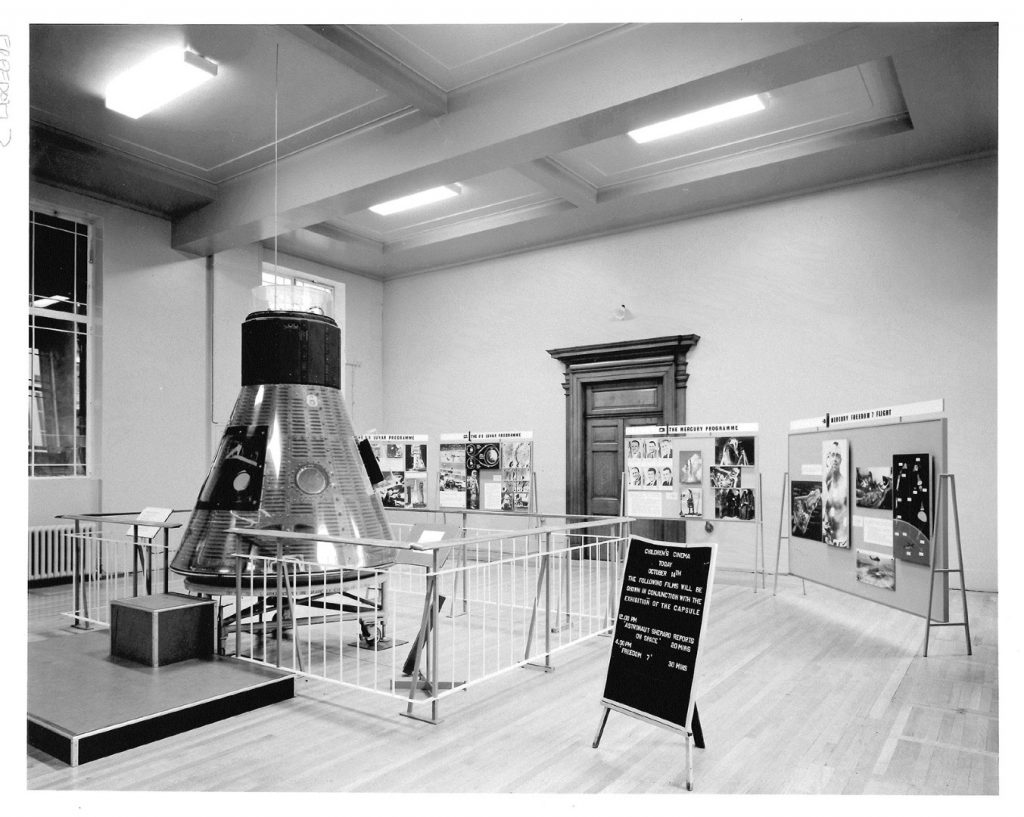
From the examination of the photographic evidence documenting the Freedom 7 special exhibition emerges a vision of this display as a highly structured and dynamic one. Somehow, the capsule works in the general economy of the display like a celestial body of great mass setting surrounding bodies in movement. The exhibition space, as viewed from above, can be inscribed in the ellipse of an imaginary orbit revolving around the capsule, which occupies one of the focal points. The title panel and the showcase are positioned along the main axis.
The display is clearly guided by some strong theoretical principles regarding how science and technology should be put on show at the Science Museum. The astronomical metaphor is not completely gratuitous, since Henry Reginald Calvert, the Keeper of the Science Museum’s Department of Astronomy and Geophysics, can be recognised as the principal source of inspiration for the construction of the display. In order to understand the museographical reflection underlying this exhibition we have to turn to him, and a note he authored in 1950, detailing his approach to the ‘presentation of technical information in the Science Museum’ (Calvert, 1950).
'This then should be our method'
https://dx.doi.org/10.15180/140105/010There is a direct link between the Freedom 7 special exhibition and Henry Calvert, who had been given the task, in 1962, to start developing the Science Museum’s space science and technology section (Millard, 2010). Several people from various departments of the Museum actively participated in the making of the 1965 exhibition. But the person in charge of coordinating the Freedom 7 project was Donovan Chilton, then a Keeper of the Science Museum’s Department of Communication and Engineering. Chilton’s previous posting had been as a Deputy Keeper in Henry Calvert’s Department of Astronomy and Geophysics. No doubt the museological training he received at that time incorporated Calvert’s thinking on museum practices, whose influence, as we will see, can be recognised in this mid-1960 display. A summary of Calvert’s reflections appears in a note he authored in October 1950. A close reading of this document should thus give us access to the intellectual foundations of the display discussed above.
In this note, as the title indicates, Calvert reflects on how displays of science and technology at the Science Museum should be assembled in order to convey ‘technical information’ to visitors. At the outset, he insists on the importance of meeting visitors’ expectations if one wants them to be interested at all. Most visitors to the Science Museum, he says, do not visit because they are primarily interested in science and technology but because it is a well-known museum in the vicinity of the Victoria and Albert Museum, and which ought to be visited. ‘This type of visitor’, Calvert continues, ‘wants something simple and striking, if not amusing.’
These visitors, Calvert states, do not want to spend time reading erudite labels, instead they want to be entertained. As evidence to support this statement, Calvert suggests that ‘the Children’s Gallery and the working exhibits in other galleries (e.g. Illumination & Locomotives) are what make an impression on them’. Hence, objects should ideally be three-dimensional, should be moving, and visitors should be able to start and stop them.
But aesthetics should not be neglected either. Attractive objects, or objects displayed in an arresting way, will be more efficient at getting a point across to visitors than bland ones, because they will hold visitors’ attention. Here Calvert alludes to the idea that pleasure – visual, or provoked by the idea of encountering an object associated with a remarkable episode in the history of science and technology – is an important dimension of what makes a display successful:
‘The aesthetic appearance of the object and the aesthetics of presentation are also important. Visitors will stop to look at an object which is attractive in itself or which is attractively displayed. If objects are overcrowded the visitor walks past them without looking at any.’ (Calvert, 1950)
Further, objects can set visitors in motion, and move them to look at other exhibits, thus suggesting that a judiciously chosen object can serve to suggest itineraries and to draw attention to artefacts that may have been overlooked, had they been put on display on their own.
‘Once interest in an exhibit has been aroused there is a slight chance with certain types of visitor that they will read the label attached to that exhibit and may even go on to read about the other objects in the same group.’ (Calvert, 1950). Calvert then concluded his note in a rather programmatic manner:
‘This then should be our method: to attract people to an object by good showmanship, and when their interest is aroused to make sure that the instructive explanation is easily at hand to satisfy their curiosity.’ (Calvert, 1950)
The panels installed at the back of Freedom 7 played exactly that role, the physical organisation of the display materialising Calvert’s theoretical discourse. The same role of providing additional information was imparted to the films shown in the Children’s Gallery cinema in conjunction with the exhibition. Emerging from this note is a conception of visitors as entertainment-seekers. But it also indicates a belief in the notion of self-improvement, as it suggests that given the appropriate motivation, visitors will want to learn more about an object or a group of objects, after their attention has been attracted.
In light of the above discussion of Calvert’s note, the display of Freedom 7 can be interpreted as an opportunity seized by the Museum to advertise its own nascent collection of objects related to space conquest. As we saw, the models exhibited alongside the capsule were part of the first batch of models related to space obtained by the Museum. As will be remembered, Plenderleith reported that the Museum would not lend the models to Edinburgh afterwards, because ‘the permanent collection had been temporarily weakened’ and that they ‘would require to be returned to the permanent display’ (Plenderleith, 1965). In the first place, this confirms that there was not much left in the permanent collection after these models had been removed. Second, it suggests that it was considered important that visitors could find these models again in the permanent display after the special exhibition was over, the models exhibited together with Freedom 7 in their turn drawing visitors’ attention to the rest of the nascent collection.
In the light of this note of 1950, then, the Freedom 7 special exhibition is transformed from a topical temporary exhibition into an important event in the history of the Museum. Although a ‘Space Gallery’ was first mentioned in the 1969 Museum report (Millard, 2010), this 1965 display can be seen as already ratifying the notion of a space science and technology section in the permanent collection[16]. Further, it stands as evidence that although space science was still in a nascent stage, the Science Museum approached it from a historical perspective. This suggests that in the 1960s, in line with the injunction from Frank Sherwood Taylor in 1955, this institution conceived of its mission as that of producing and imparting a historical knowledge of science, doing so through the coordinated display of a series of artefacts representing the evolution of a given field, and drawing attention to such collections with an appropriately chosen ‘star object’.
Conclusion
https://dx.doi.org/10.15180/140105/011This case study of the six-month exhibition of the Mercury capsule Freedom 7 in 1965–66 at the Science Museum in London shows how one display of scientific and technological knowledge was informed by reflections elaborated in the 1950s. Henry Calvert’s note emphasised the dynamic use of artefacts to set visitors in motion, and advocated an aesthetic based on the attractive display of a well-chosen artefact rather than on displaying vast numbers of objects. It also articulated a conception of visitors as entertainment-seekers, whilst expressing a belief in the individual drive for self-improvement. As Plenderleith’s report demonstrated, foremost amongst museum curators’ preoccupations in the 1960s was a concern for back-up material, as a means of putting to good use the drawing power of what could be called ‘charismatic’ artefacts. Further, the Freedom 7 special exhibition was identified as an early attempt at historicising space science and technology, and as the public initiation of the space science and technology section in the Museum’s permanent collection.
In this respect, the paper reinforces the argument for a re-evaluation of the status of temporary exhibitions as meaningful markers in understanding the history of museum practices (Morris, 2010b). Temporary exhibitions have been defined as topical events enabling the Museum to present science in the making. They should also be understood as moments in the history of the Science Museum meant to inaugurate the historicising of emerging fields in science and technology by this institution. The present case study is meant to invite comparison. Further research and more case studies of other exhibitions for the period would help confirm or invalidate the analysis presented here.
Finally, this paper has been an attempt at demonstrating the significance of visual sources for the historiography of museum practices. Photographic records of exhibitions allow us to get a sense of what visitors actually saw, and to deepen our understanding of what the spatial experience of visiting may have been. Photographs, albeit two-dimensional records, show displays as dynamic entities rather than static ones, in which objects have the power to set visitors in motion.
Tags
Footnotes
Back to text
Back to text
Back to text
Back to text
Back to text
Back to text
Back to text
Back to text
Back to text
Back to text
Back to text
Back to text

